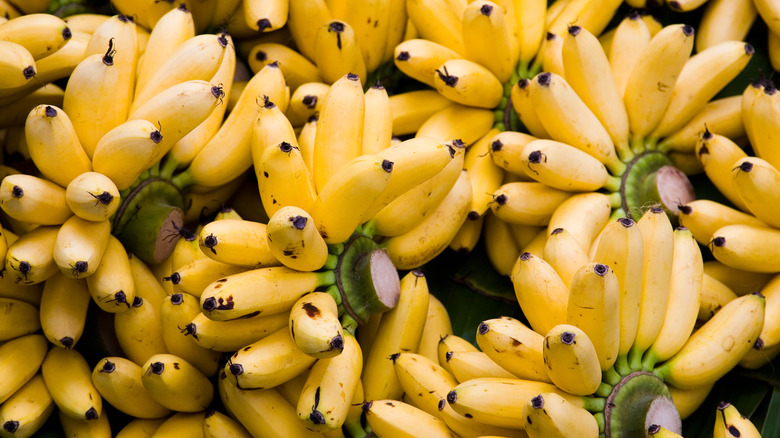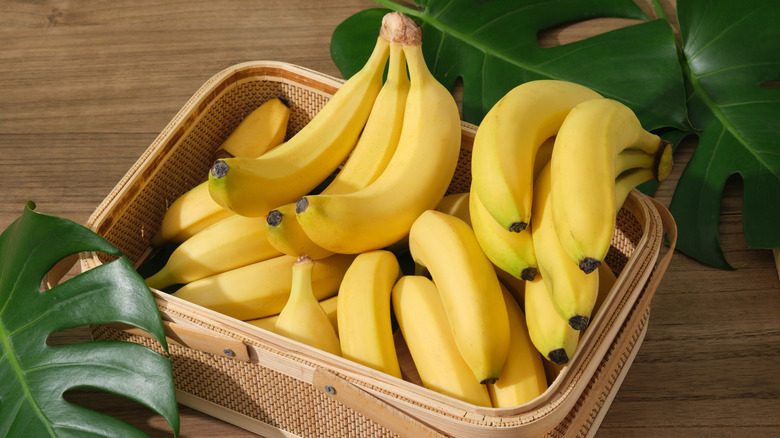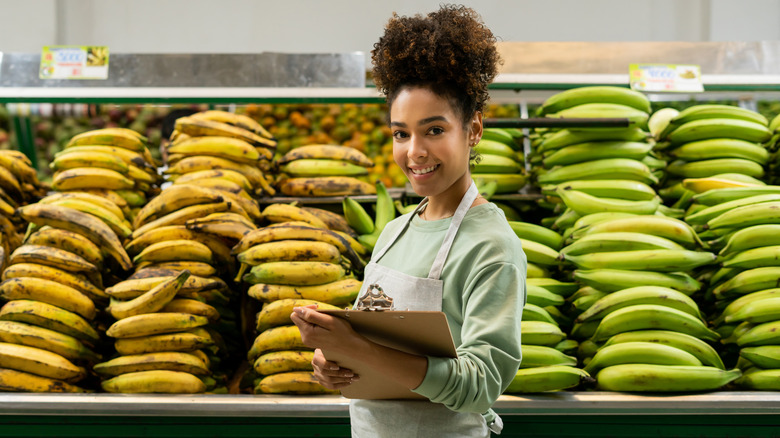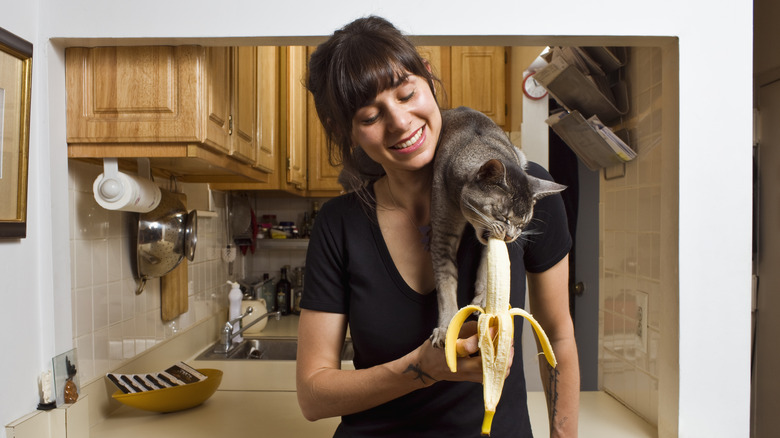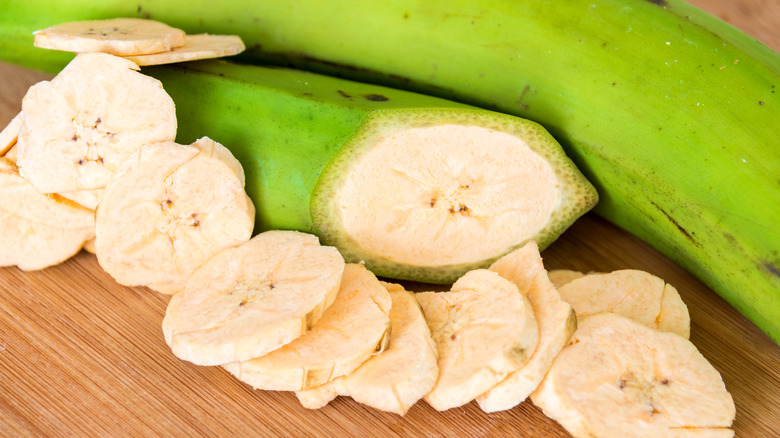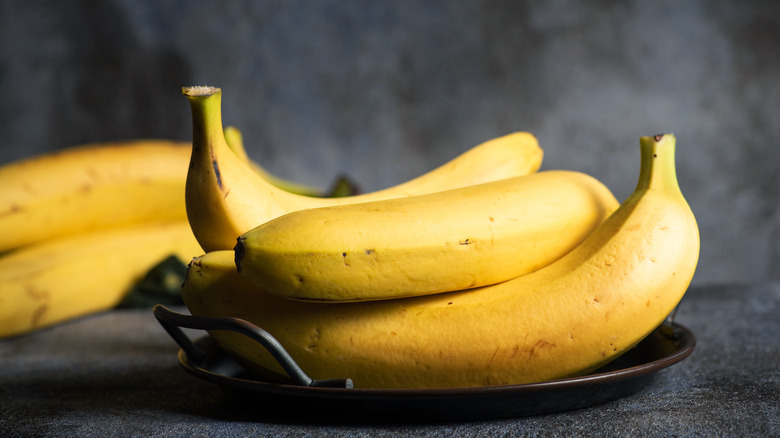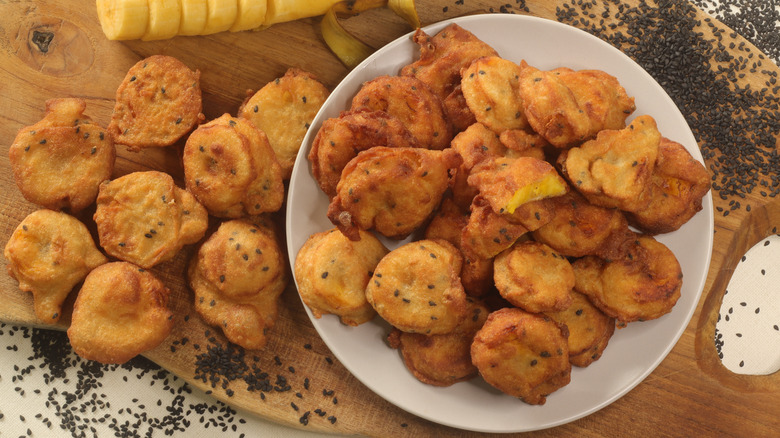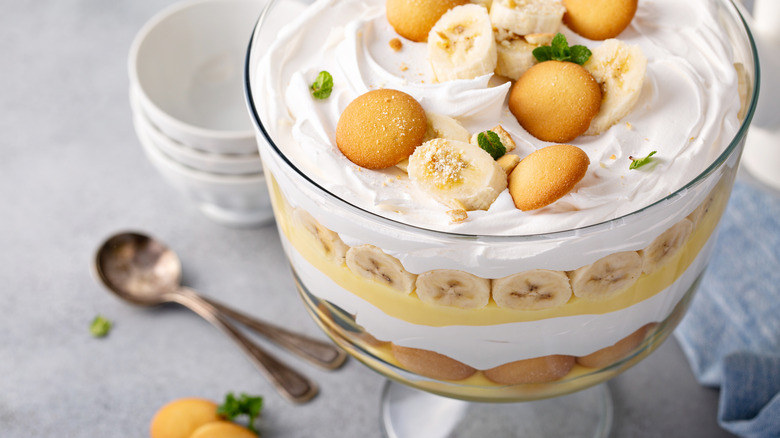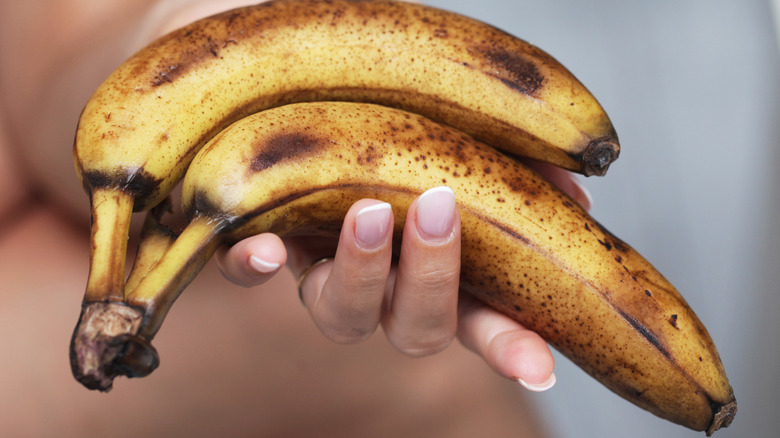Bananas Vs Plantains: What's The Difference And How Do You Use Them?
If you've ever confused a plantain for a banana, you're not alone. These two long, yellow fruits could be twins — if one twin were a little bit bigger and starchier than the other. It's easy to assume they're actually the same thing ... which they kind of are.
Both bananas and plantains are hybrids, created by crossing two wild species called Musa acuminata and Musa balbisiana. While they're not exactly the same thing, you could say they're siblings. But, like most siblings, though they look alike, they have very different characteristics. One is sweet, one is savory. One is big, one is small. One can be eaten out of hand, one needs to be cooked before eating. They also work best in completely different dishes, so mixing them up isn't ideal. Don't worry, though: By the time this article is finished, you won't need a name tag to tell these two lookalikes apart anymore. We're breaking down every difference between bananas and plantains, and explaining how best to use them.
What is a banana?
You're probably very familiar with the banana. But if you're not, here's a breakdown: It's a long, slender fruit with a yellow peel on the outside and a soft interior that tastes great on its own or with a spoonful of peanut butter. But there's more to this fruit than just "fruit." For one thing, a banana isn't just any type of fruit – it's a berry. This is due to the fact that it is grown in bunches, emerges from a single flower with a single ovary, and is full of seeds (you may not always notice them, but bananas are indeed full of tiny black seeds).
But a banana can actually be classified as an herb as well. Even though we often throw around the phrase "banana tree," the plants bananas grow on actually have no woody stalk. Instead, they have a "pseudostem," which is formed by leaves that are tightly rolled around one another. Oh, and to make things even more bananas, these herbaceous banana plants can appear to "walk" up to 15 inches over the course of their lifetime. This is because they are cultivated by humans with two different plant shoots as opposed to springing up from the ground naturally. These shoots grow along the top of the ground, and their two different growth cycles make the plant move slightly (and slowly) over time.
What is a plantain?
On the surface, plantains and bananas share a lot of characteristics. They both grow from the same type of herbaceous plant, for example, and they're both long and often yellow. Plantains, however, can also be eaten when they are green or even when they're a brownish-yellow or black. They're also bigger than bananas at around 12 inches long as opposed to 6 inches. Also unlike bananas, they are usually cooked and eaten with meals instead of as a raw snack or dessert. Thanks to their high level of starchiness, plantains are more similar to a potato than a fruit, and are usually cooked in similar ways (case in point: mashed plantains).
Plantains are most commonly produced and consumed in West and Central Africa, Latin America, and the Caribbean. While Americans might not be as familiar with them as they are with bananas, plantains are actually the world's 10th most important staple food. They are a vital resource, especially in developing countries, because they're available all year long. In fact, according to The Plantain Council, plantains and bananas provide more than 70 million people with up 25% of their food energy requirements.
Bananas are usually eaten raw
If you're not sure whether you have a banana or a plantain on your hands, the best way to find out is to take a bite. While they can also be cooked, bananas taste great when eaten raw, and have a sweetness to them that makes them a favorite fruit, even among people who don't usually enjoy fruit at all.
If you try to peel and eat a plantain right off the counter, however, you'll most likely regret it. Technically, plantains can be eaten raw, but their flavor is not nearly as good as that of their lookalikes. Plantains are very high in starch, so they taste better when they're cooked. Think of it this way: Would you eat a potato straight out of the bag without boiling, frying, or otherwise cooking it? We didn't think so. Cooked potatoes are best, and so are cooked plantains.
Bananas and plantains might look alike, but they taste very different. The best way to keep track of which is which is to remember that bananas are sweet and plantains taste better in savory dishes.
Plantains can be eaten before they're ripe
Bananas are best enjoyed when they're ripe, after their peel has turned from green to yellow. There are a few exceptions to this rule, like when green bananas are used in some savory Caribbean dishes in place of plantains. But typically, the best banana is either ripe or slightly over-ripe. Over-ripe bananas are even sweeter than the ripe ones, which is why they're often called for when making banana bread.
Plantains, on the other hand, can be enjoyed ripe, under-ripe, or over-ripe. The under-ripe ones are green, and can be boiled or fried for a tasty, savory treat. They get sweeter as they get riper, with their ultimate sweetness coming when their skin is mostly black, but they're still firm to the touch.
Ripeness can also affect the peeling process. While bananas are pretty easy to peel regardless of their maturity, plantains have a more leathery skin and can't be peeled easily with just your hands. To peel a plantain, you will have to cut off the ends with a paring knife, then score the skin at its seams. Then use the blade of the knife to pry up the peel without cutting the firm fruit of the plantain itself. Then voila! Your plantain is ready to cook.
Both are healthy fruits
When it comes to nutrition, both bananas and plantains are big winners. They both contain magnesium, potassium, vitamin C, antioxidants, and fiber, and they're both a good source of complex carbohydrates. But still, the two fruits (or herbs, or berries) are not identical. Even though they both have those complex carbs, they have different amounts of them that derive from different sources. Bananas contain around 23 grams of carbs for every 100 grams, but those carbs come from sugars. Plantains, instead, have 32 grams of carbs per 100 grams of fruit, but their carb count comes from starch.
Bananas and plantains can both help regulate your digestive system, with the fiber in plantains making them especially good for those trying to avoid developing inflammatory bowel diseases. Bananas also have probiotics and prebiotics, which fill your gut with good bacteria and the carbs that feed them (prebiotics are food for probiotics, FYI). Both can help fend off heart disease as well.
Plantains are used like a vegetable
In some places in the U.S., plantains are quite the mystery. If you fall into this category, you might know they aren't the same thing as bananas, but be clueless as to what you're supposed to do with them. Since these "fruits" don't really have a fruity taste, they're used more like vegetables. They commonly appear on the table as a side dish to a main entrée, and can be boiled, fried, baked, or sautéed, alone or with vegetables, herbs, and spices.
Plantains are most common in Central and South America, the Caribbean, and African nations like Nigeria and Ghana. In Puerto Rico, Cuba, and the Dominican Republic, for example, they're a significant part of the culture. Here, you'll find dishes like tostones, which are green plantains that have been fried until they are crispy and golden brown. Maduros, on the other hand, are plantains that have been fried when they are over-ripe, resulting in a sweet dessert. Plantains can also be cooked in rice with olives, mashed up with pork, and eaten simply boiled or baked like potatoes — and that's just the beginning of the world's plantain possibilties.
Bananas are used in sweet dishes
Unlike plantains, which are typically cooked in savory dishes, bananas are almost always used in desserts. You can make smoothies or puddings out of raw bananas, or you can slice them up and use them as a topping for cereal or oatmeal to add some sweetness without adding refined sugar. There's also the ever-popular banana split, where bananas serve as a base for an array of tasty ice cream flavors and toppings.
Speaking of ice cream, Bananas Foster is a classic treat made by cooking bananas in butter, brown sugar, vanilla, cinnamon and rum and drizzling the resulting mixture over vanilla ice cream. You can also bake banana bread, which is a delicious way to use up bananas that have gotten too ripe. Bananas can also go into cakes, pastries, and even things like banana, chocolate, and peanut butter brownies. Banana pancakes can also be a great way to start the day, as can banana nut muffins.
Bananas go bad faster
Aside from the taste, the biggest difference between plantains and bananas might just be their shelf life. Bananas seem to be doomed from the moment they're picked up from the produce section. In fact, many people swear that the yellow bananas they buy at the store get spotty by the time they get home.
In general, bananas can last from two days to six days on the kitchen counter, depending on temperature, humidity, and the whims of the banana itself. The best way to store them is on a hook, so the bananas are more separated from each other, and away from sunlight. Storing them in the refrigerator slows the ripening process, but this means you shouldn't put them in there if they're still green. You can also peel and slice bananas, place them on a tray, and freeze them to make them last longer (frozen bananas are also a tasty summertime snack).
Plantains are a lot less finicky. When kept at room temperature, they can last for around three weeks. When they're half-ripe, they should be put in the refrigerator to keep them from ripening too fast. If you want your plantains to ripen, however, you can place them in a bowl with some bananas. Bananas release ethylene gas, which is a plant hormone that causes other fruits around them to ripen faster. So not only do bananas ripen too quickly, they also ripen everything else along with them!
